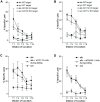The Role of T Cell Costimulation via DNAM-1 in Kidney Transplantation
- PMID: 26840537
- PMCID: PMC4739582
- DOI: 10.1371/journal.pone.0147951
The Role of T Cell Costimulation via DNAM-1 in Kidney Transplantation
Abstract
DNAX accessory protein-1 (DNAM-1, CD226) is a co-stimulatory and adhesion molecule expressed mainly by natural killer cells and T cells. DNAM-1 and its two ligands CD112 and CD155 are important in graft-versus-host disease, but their role in solid organ transplantation is largely unknown. We investigated the relevance of this pathway in a mouse kidney transplantation model. CD112 and CD155 are constitutively expressed on renal tubular cells and strongly upregulated in acutely rejected renal allografts. In vitro DNAM-1 blockade during allogeneic priming reduced the allospecific T cell response but not the allospecific cytotoxicity against renal tubular epithelial cells. Accordingly, absence of DNAM-1 in recipient mice or absence of CD112 or CD155 in the kidney allograft did not significantly influence renal function and severity of rejection after transplantation, but led to a higher incidence of infarcts in CD112 and CD155 deficient kidney allografts. Thus, DNAM-1 blockade is not effective in preventing transplant rejection. Despite of being highly expressed, CD112 and CD155 do not appear to play a major immunogenic role in kidney transplantation. Considering the high incidence of renal infarcts in CD112 and CD155 deficient grafts, blocking these molecules might be detrimental.
Conflict of interest statement
Figures






Similar articles
-
Functional characterization of DNAM-1 (CD226) interaction with its ligands PVR (CD155) and nectin-2 (PRR-2/CD112).Int Immunol. 2004 Apr;16(4):533-8. doi: 10.1093/intimm/dxh059. Int Immunol. 2004. PMID: 15039383
-
Increased CD112 expression in methylcholanthrene-induced tumors in CD155-deficient mice.PLoS One. 2014 Nov 10;9(11):e112415. doi: 10.1371/journal.pone.0112415. eCollection 2014. PLoS One. 2014. PMID: 25384044 Free PMC article.
-
Boosting Natural Killer Cell-Mediated Targeting of Sarcoma Through DNAM-1 and NKG2D.Front Immunol. 2020 Jan 28;11:40. doi: 10.3389/fimmu.2020.00040. eCollection 2020. Front Immunol. 2020. PMID: 32082316 Free PMC article.
-
DNAM-1 and the TIGIT/PVRIG/TACTILE Axis: Novel Immune Checkpoints for Natural Killer Cell-Based Cancer Immunotherapy.Cancers (Basel). 2019 Jun 23;11(6):877. doi: 10.3390/cancers11060877. Cancers (Basel). 2019. PMID: 31234588 Free PMC article. Review.
-
DNAM-1 versus TIGIT: competitive roles in tumor immunity and inflammatory responses.Int Immunol. 2021 Nov 25;33(12):687-692. doi: 10.1093/intimm/dxab085. Int Immunol. 2021. PMID: 34694361 Review.
Cited by
-
Expression of the Inhibitory Receptor TIGIT Is Up-Regulated Specifically on NK Cells With CD226 Activating Receptor From HIV-Infected Individuals.Front Immunol. 2018 Oct 10;9:2341. doi: 10.3389/fimmu.2018.02341. eCollection 2018. Front Immunol. 2018. PMID: 30364127 Free PMC article.
-
CD226: An Emerging Role in Immunologic Diseases.Front Cell Dev Biol. 2020 Jul 24;8:564. doi: 10.3389/fcell.2020.00564. eCollection 2020. Front Cell Dev Biol. 2020. PMID: 32850777 Free PMC article.
-
The Immune Regulatory Functions of CD226 and Its Implications in Immune-Mediated Diseases.Biomolecules. 2025 Jul 14;15(7):1007. doi: 10.3390/biom15071007. Biomolecules. 2025. PMID: 40723878 Free PMC article. Review.
-
The Ratio of CD226 and TIGIT Expression in Tfh and PD-1+ICOS+Tfh Cells Are Potential Biomarkers for Chronic Antibody-Mediated Rejection in Kidney Transplantation.J Immunol Res. 2022 Jun 12;2022:5326083. doi: 10.1155/2022/5326083. eCollection 2022. J Immunol Res. 2022. PMID: 35733922 Free PMC article.
-
TIGIT regulates CD4+ T cell immunity against polymicrobial sepsis.Front Immunol. 2024 Mar 13;15:1290564. doi: 10.3389/fimmu.2024.1290564. eCollection 2024. Front Immunol. 2024. PMID: 38545097 Free PMC article.
References
-
- Kraus AK, Cippa PE, Gaspert A, Chen J, Edenhofer I, Wuthrich RP, et al. Absence of donor CD40 protects renal allograft epithelium and preserves renal function. Transplant international: official journal of the European Society for Organ Transplantation. 2013;26(5):535–44. - PubMed
-
- Shibuya A, Campbell D, Hannum C, Yssel H, Franz-Bacon K, McClanahan T, et al. DNAM-1, a novel adhesion molecule involved in the cytolytic function of T lymphocytes. Immunity. 1996;4(6):573–81. - PubMed
Publication types
MeSH terms
Substances
LinkOut - more resources
Full Text Sources
Other Literature Sources
Medical
Molecular Biology Databases
Research Materials

